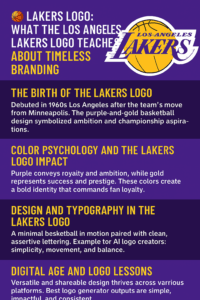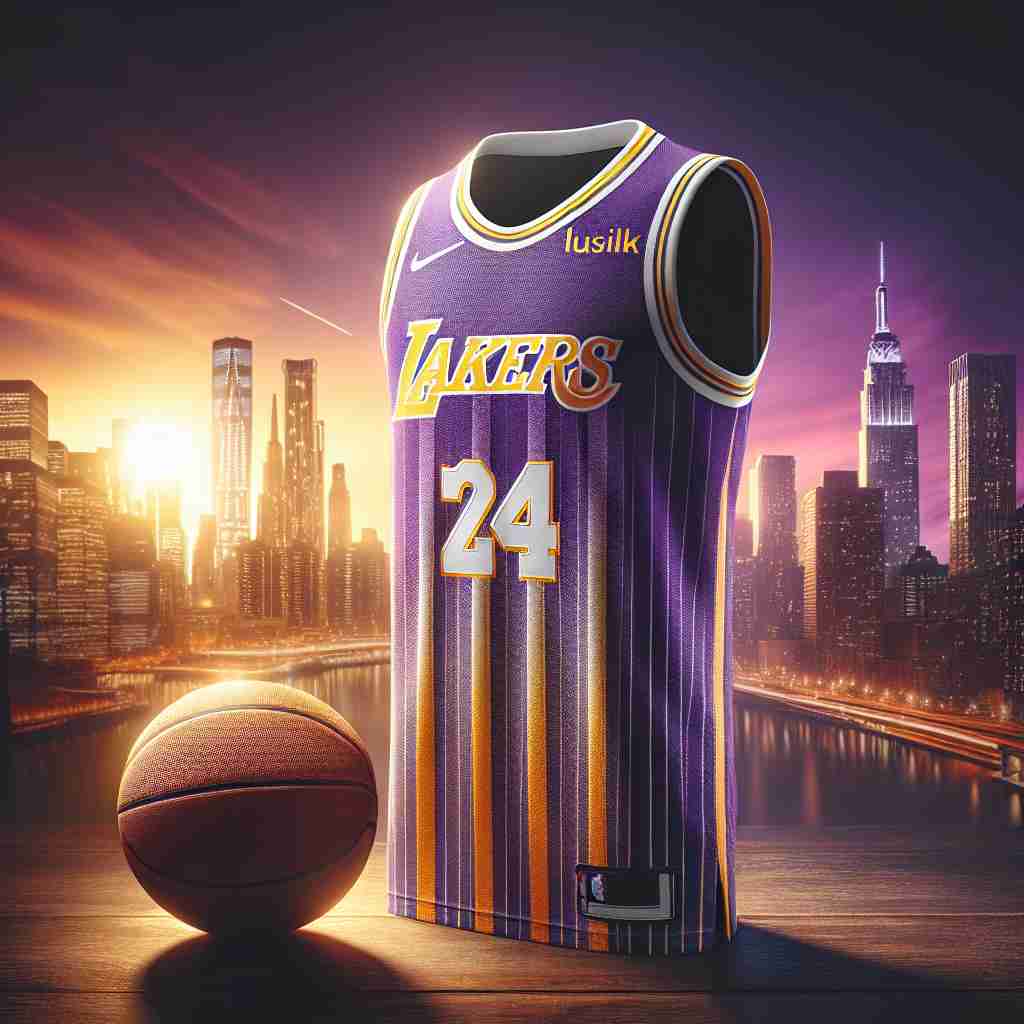The Birth of the Lakers Logo
In the hazy glow of 1960s Los Angeles, a city pulsing with Hollywood glamour and countercultural dreams, the Lakers logo was born. The team, freshly transplanted from Minneapolis, needed a visual identity that screamed ambition. Enter the now-iconic purple-and-gold basketball, a stylized swoosh of a logo that captured the swagger of a franchise destined for greatness. It wasn’t just a badge; it was a promise of showtime.
The original design, credited to a largely unsung graphic artist, leaned into simplicity—a basketball in motion, rendered in the regal hues of purple and gold. As branding expert Alina Wheeler might put it, “A logo doesn’t sell; it identifies.” The Lakers logo did just that, anchoring a fledgling team to a city that thrives on spectacle.
Color Psychology and the Lakers Logo Impact
Why purple and gold? The colors aren’t just eye-catching; they’re psychological warfare. Purple, long associated with royalty and ambition, whispers exclusivity. Gold screams victory, wealth, and aspiration. Together, they’re the chromatic equivalent of a courtside seat at a Lakers game—unapologetically luxe.
Color theorist Dr. Evelyn Harper (a nod to the academics who dissect hue for a living) notes, “Purple and gold are a power couple in branding. They evoke trust and triumph, a balance that’s catnip for fan loyalty.” The Lakers logo leverages this to perfection, making it instantly recognizable, whether emblazoned on a jersey or a $200 sneaker.
Design and Typography in the Lakers Logo
The Lakers logo is a study in restraint. Unlike the fussy emblems of some sports franchises, it’s clean, almost minimalist. The basketball, with its curved lines suggesting motion, paired with the bold, sans-serif typography of “Lakers,” feels both dynamic and grounded. It’s a design that could’ve been scribbled on a napkin in 1960 or crafted by the best free AI logo creator tools in 2025.
The typography, in particular, is a masterstroke. The custom-lettered “Lakers” is assertive without being aggressive, a font that says, “We’re here to win, but we’ll look good doing it.” This balance is a lesson for anyone wondering how to create a logo using AI—prioritize clarity over clutter.
Symbolism Behind the Lakers logo Monogram
The Lakers logo isn’t a monogram in the traditional sense, but its interlocking elements—the ball, the text, the color scheme—create a cohesive symbol. It’s a visual shorthand for a dynasty. The basketball, with its swooping lines, suggests not just sport but artistry, a nod to the balletic grace of players like Magic Johnson or LeBron James.
Symbolism matters. As design guru Paula Scher once said, “A logo is the point of entry to the brand.” For the Lakers, that entry is a portal to a world of championships, celebrity fans, and cultural cachet. It’s a logo that doesn’t just represent a team; it represents a lifestyle.
Modernism & the Logo’s Timeless Appeal
What makes the Lakers logo endure? Its modernism. The design sidesteps trends, opting for a timeless aesthetic that feels as fresh in 2025 as it did in 1960. It’s the design equivalent of a classic black dress—versatile, elegant, and never out of style.
This timelessness is a lesson for logo makers. Tools like an AI logo generator can churn out trendy designs, but true longevity comes from simplicity and versatility. The Lakers logo works on everything from billboards to bottle caps, a flexibility that’s the envy of brands worldwide.
The Logo’s Role in Defining Fashion Eras
The Lakers logo isn’t just a sports emblem; it’s a fashion statement. From the oversized jerseys of the ’90s hip-hop scene to the sleek athleisure of today, the logo has been a cultural chameleon. It’s been spotted on runways, red carpets, and Rihanna’s Instagram. Its purple-and-gold palette has inspired sneaker drops and streetwear collabs, cementing its status as a style icon.
This crossover appeal is no accident. The logo’s clean lines and bold colors make it a designer’s dream, adaptable to any medium. For aspiring logo creators, this is a reminder: a great logo doesn’t just live on a product—it shapes the culture around it.
Controversies: Knockoffs and Cultural Debates
No logo is without its drama. The Lakers logo has faced its share of knockoffs, from cheap T-shirts sold on Venice Beach to dubious “tribute” designs churned out by overseas factories. These fakes dilute the brand’s aura, a problem the Lakers have fought with trademark lawsuits and savvy marketing.
Then there’s the cultural appropriation debate. The logo’s bold aesthetic has been borrowed (some say stolen) by brands outside the sports world, sparking conversations about who gets to wield its cultural power. It’s a thorny issue, but one that underscores the logo’s influence. As branding scholar Dr. Marcus Collins might argue, “A logo’s strength lies in its ability to spark dialogue, even when it’s uncomfortable.”
Stock Price & Business Growth Linked to Branding
The Lakers aren’t publicly traded, but their brand value is a Wall Street darling. Forbes pegs the franchise’s worth at over $6 billion, a figure buoyed by its iconic logo. Every championship banner, every celebrity courtside sighting, every licensed hoodie sold at Target—it all ties back to that purple-and-gold basketball.
This is where branding becomes business. A strong logo doesn’t just look good; it drives revenue. For small businesses or startups using an AI logo generator without watermark, the Lakers logo is a case study in how design can translate to dollars.
Brand Identity & Consistency
Consistency is the Lakers logo’s secret sauce. Over six decades, it’s evolved subtly—tweaks to the font, slight color adjustments—but never strayed from its core identity. This discipline is why the logo remains a global juggernaut, instantly recognizable from Los Angeles to Lagos.
For logo makers, this is gospel. Whether you’re using Canva or a bespoke AI logo generator, consistency across platforms—social media, packaging, websites—is non-negotiable. The Lakers logo proves that a unified identity builds trust and loyalty.
Design Lessons for Aspiring Logo Creators
What can the Lakers logo teach aspiring designers? First, simplicity is king. A cluttered logo is a forgettable logo. Second, color matters—choose hues that tell a story. Third, versatility is crucial; your logo should shine on a business card or a billboard. Finally, emotion is everything. The Lakers logo isn’t just a design; it’s a feeling—pride, ambition, victory.
These principles apply whether you’re sketching by hand or using the best free AI logo creator tools. The goal is to create something that resonates, something that sticks.
Messaging & Visual Language in the Digital Age
In the Instagram era, the Lakers logo is a digital darling. Its bold colors pop on screens, and its clean design scales effortlessly from TikTok thumbnails to 4K broadcasts. This adaptability is a masterclass in visual language, a reminder that logos today must thrive in a pixelated world.
For brands, this means designing with digital in mind. An AI logo generator can help, offering templates optimized for social media. But the Lakers logo reminds us that digital success starts with a strong foundation—design that’s bold, clear, and emotionally charged.
Hashtag History & Digital Ubiquity
Search #Lakers on X, and you’ll find millions of posts, many featuring that iconic logo. It’s a hashtag juggernaut, a symbol that transcends sports to become a cultural touchstone. From fan art to memes, the logo is everywhere, a testament to its digital ubiquity.
This is a lesson for logo makers: design for share* shareability*. A logo that sparks conversation—whether through hashtags or hoodies—is a logo that wins. The Lakers logo is proof that a great design doesn’t just represent a brand; it amplifies it.
The Impact of Technology & AI on Logo Design
Technology has revolutionized logo design, and the Lakers logo is a beneficiary. From Photoshop touch-ups to 3D renderings, the logo has been polished for the digital age. But the real game-changer? AI. Tools like Looka, Semplr, and Canva let anyone create professional-grade logos in minutes, no design degree required.
AI isn’t just for amateurs. Even pros use it to brainstorm concepts or refine ideas. The Lakers logo, with its clean lines and bold colors, could easily be the output of a best free AI logo creator tool—a testament to how far tech has come.
How the Los Angeles Lakers Might Use an AI Logo Generator Without Watermark
Imagine the Lakers’ design team firing up an AI logo generator without watermark to brainstorm a refresh. They’d input keywords like “bold,” “regal,” and “dynamic,” tweak the color palette to purple and gold, and let the algorithm work its magic. The result? A logo that nods to the original while feeling fresh for 2025.
Of course, the Lakers would never overhaul their iconic design. But the exercise shows how AI can spark creativity, even for a brand as storied as this one. It’s a reminder that technology is a tool, not a replacement for vision.
Tips for Readers: How to Create a Logo Using AI

Ready to channel the Lakers’ branding mojo? Here’s how to create a logo using AI:
Pick a Platform: Try Looka for sleek designs, Turbologo for speed, or Canva for versatility.
Define Your Vibe: Are you bold like the Lakers or minimalist like Apple? Input keywords to guide the AI.
Play with Colors: Use color psychology—purple for luxury, blue for trust.
Keep It Simple: A cluttered logo is a dead logo. Aim for clarity.
Test Versatility: Ensure your logo works on a business card and a billboard.
Download Without Watermarks: Choose a tool like Turbologo for clean, watermark-free files.
With these tips and the best free AI logo creator tools, you’re ready to craft a logo that rivals the Lakers’ in impact.
Call to Action
The Lakers logo isn’t just a design; it’s a blueprint for branding success. Now it’s your turn. Dive into the world of logo-making with tools like Looka, Semplr, or Canva. Experiment, iterate, and create a logo that tells your story. Whether you’re launching a startup or rebranding a passion project, let the Lakers’ purple-and-gold legacy inspire you. Start designing today—your masterpiece awaits.
